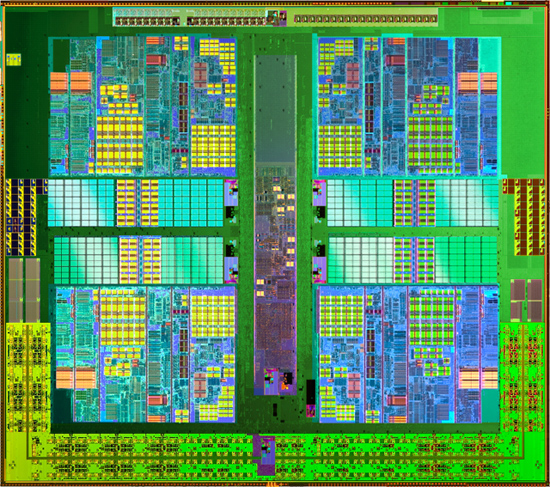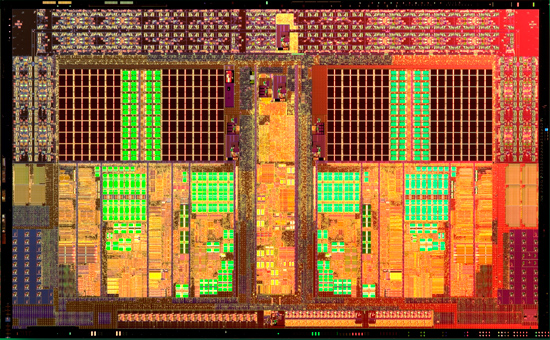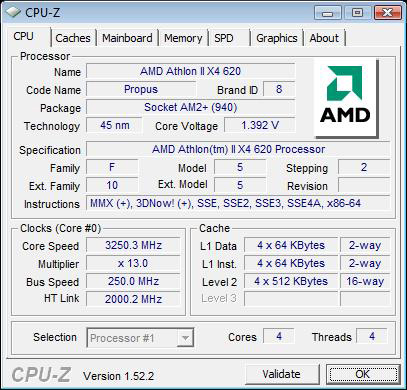AMD Athlon II X4 620 & 630: The First $99 Quad Core CPU
by Anand Lal Shimpi on September 16, 2009 12:00 AM EST- Posted in
- CPUs
How does AMD respond to Lynnfield? Is it by drastically cutting prices on Phenom II? Nope. By introducing the world’s first quad-core processor to debut at $99. Now that’s cool.

It’s called the Athlon II X4 and its existence shouldn’t be any surprise. AMD quietly announced it along with the Athlon II X2 line.

Today we get two models: the Athlon II X4 630 and the Athlon II X4 620, priced at $122 and $99 respectively. The only difference between the two is clock speed; the 630 runs at 2.8GHz while the 620 runs at 2.6GHz. These are both AM3 chips meaning they'll work in AM3 motherboards with DDR3 memory or AM2+ boards with DDR2 memory.
| Processor | Clock Speed | L2 Cache | L3 Cache | TDP | Price |
| AMD Phenom II X4 965 BE | 3.4GHz | 2MB | 6MB | 140W | $245 |
| AMD Phenom II X4 955 BE | 3.2GHz | 2MB | 6MB | 125W | $245 |
| AMD Phenom II X4 945 | 3.0GHz | 2MB | 6MB | 125W | $225 |
| AMD Phenom II X3 720 BE | 2.8GHz | 1.5MB | 6MB | 95W | $145 |
| AMD Phenom II X2 550 BE | 3.1GHz | 1MB | 6MB | 80W | $105 |
| AMD Athlon II X4 630 | 2.8GHz | 2MB | 0MB | 95W | $122 |
| AMD Athlon II X4 620 | 2.6GHz | 2MB | 0MB | 95W | $99 |
| AMD Athlon II X2 250 | 3.0GHz | 2MB | 0MB | 65W | $87 |

This isn’t a harvested Phenom II nor is it a pair of Athlon II X2s, instead it looks like we have a brand new die on our hands (some Athlon II X4s will be crippled Phenom IIs but AMD insists that the new die will be used). The Athlon II X4 has four cores on a single die, but unlike the Athlon II X2 each core only has a 512KB L2 per core. You can tell by the die shot that the core-to-cache ratio is much higher than on the X2:

The 45nm Athlon II X4 Propus die

The 45nm Athlon II X2 die (note the larger L2 per core)
Like the rest of the Athlon II lineup there is no L3 cache. This helps keep the die small (and affordable) but also hurts performance:
| Processor | SYSMark 2007 Overall | E-Learning | Video Creation | Productivity | 3D |
| AMD Phenom II X4 920 (2.8GHz) | 173 | 151 | 212 | 167 | 167 |
| AMD Athlon II X4 630 (2.8GHz) | 157 | 128 | 221 | 131 | 162 |
| % of Phenom II X4 | 91% | 85% | 104% | 78% | 97% |
At the same clock speed the Athlon II X4 should offer roughly 90% of the performance of a Phenom II X4.
| Processor | Cores | Manufacturing Process | L1 Cache | L2 Cache | L3 Cache | Die Size | Transistor Count |
| AMD Phenom II X4 | 4 | 45nm | 128KB per core | 512KB per core | 6MB | 258 mm2 | 758M |
| AMD Athlon II X4 | 4 | 45nm | 128KB per core | 512KB per core | 0MB | 169 mm2 | 300M |
| AMD Athlon II X2 | 2 | 45nm | 128KB per core | 1MB per core | 0MB | 117 mm2 | 234M |
| Intel Core 2 Quad Q8xxx | 4 | 45nm | 64KB per core | 4MB | 0MB | 164 mm2 | 456M |
The price is unbeatable. If we ignore the 630 for a moment, the Athlon II X4 620 is by far the cheapest route to four cores on the market. Intel’s most affordable quad-core is the Core 2 Quad Q8200 at $163, while AMD would previously charge you $163 for a Phenom X4 9600B. This is where the AM3/AM2+ compatibility play really helps out. Motherboard/memory costs are as cheap as possible thanks to AMD's incredible socket flexibility.

And just in case you’re wondering, yes, the Athlon II X4 620 actually delivers performance competitive with the Q8200 but for 60% of the cost. It’s not all that clear cut, there are some cases where the 620 is faster but others where the Q8200 is much faster. On average it ends up being a wash but you’ll want to pay attention to the coming pages to see how the cookie crumbles as it does vary from test to test.

Codename Propus
Overclocking isn't unfortunately as good as the Phenom IIs; the result of a conscious design decision or simply the early nature of the Propus die. That being said, without a single extra millivolt I was able to hit 3.25GHz on my Athlon II X4 620 sample - making it even more valuable. Extra voltage proved mostly useless, I could only approach 3.4GHz with an extra 300mV.
Let’s see, have I thoroughly ruined the surprise? Check. Now let’s get to the tests.
The Test
| Motherboard: | Intel DX58SO (Intel X58) Intel DX48BT2 (Intel X48) Gigabyte GA-MA790FX-UD5P (AMD 790FX) |
| Chipset: | Intel X48 Intel X58 AMD 790FX |
| Chipset Drivers: | Intel 9.1.1.1015 (Intel) AMD Catalyst 8.12 |
| Hard Disk: | Intel X25-M SSD (80GB) |
| Memory: | Qimonda DDR3-1066 4 x 1GB (7-7-7-20) Corsair DDR3-1333 4 x 1GB (7-7-7-20) Patriot Viper DDR3-1333 2 x 2GB (7-7-7-20) |
| Video Card: | eVGA GeForce GTX 280 |
| Video Drivers: | NVIDIA ForceWare 180.43 (Vista64) NVIDIA ForceWare 178.24 (Vista32) |
| Desktop Resolution: | 1920 x 1200 |
| OS: | Windows Vista Ultimate 32-bit (for SYSMark) Windows Vista Ultimate 64-bit |










150 Comments
View All Comments
Exar3342 - Wednesday, September 16, 2009 - link
$50 is pretty trvial in the overall cost of the computer. Even a relatively cheap system with a O/S and a acceptable graphics card would be $400-500. This difference is only ~%10 of the overall cost, and yields a performance increase of 20-40% and is more efficient.You are thinking small, think bigger.
With the Athlon X4 at $100 and the i5/i7 at $150-250, there is really no reason for anyone to buy a brand-new PhII system at all. If you want cheap, get the Athlon X$; if you want fast, get the i5/i7.
Patrick Wolf - Wednesday, September 16, 2009 - link
"With the Athlon X4 at $100 and the i5/i7 at $150-250, there is really no reason for anyone to buy a brand-new PhII system at all."You are thinking big, think smarter. And the i5 is $200, not $150.
The price per performance scales linearly. An Athlon X4 w/ mobo and DDR2 < PhenomII X4 w/ mobo and DDR2 < i5/i7 w/ mobo and DDR3.
You get what you pay for.
And less we forget, DDR3 isn't exactly cheap yet. And the new 1156 boards are starting at ~$100.
lopri - Wednesday, September 16, 2009 - link
To all those who worry about AMD's finance: Why do you care?It has been a great mystery to me throughout many years. Sure I understand the need for competition which benefits everyone in a free market, but there are other things that can ensure fair competition. Worrying about a corporation's profit margin is not the first on the list. I'd leave that to the management and shareholders.
Smidge - Thursday, September 17, 2009 - link
Competition is important, both for driving prices down, and driving development. As I recall, Intel started their whole tick-tock releases of architectures in response to starting to lose the lead in the processor market. As well as that they were reportedly sitting on a bunch of tech advances until they'd sold enough of their previous gen stuff. The cost savings are especially obvious when you think of how prices tend get slashed whenever the competition releases a new product, especially if it outperforms products in a higher price bracket.Now remember that AMD are the only real competition in both the CPU (x86_64) and graphics markets for Intel and Nvidia respectively. Both markets have an extremely high barrier to entry. Well, with the requirement of probably billions in startup investment and decades of processor research, it's more like a nigh-impenetrable barrier to entry. So if AMD were to go under, Intel and Nvidia would both have monopolies in their respective markets for a long time to come.
I think it's perfectly fair to worry about AMD's finances given how much it would suck for us consumers if they were to go under (as they were close to doing before the globalfoundries spinoff). As I would worry if Intel or Nvidia were struggling. Though Intel seem to be sitting on a boatload of cash so that's not much of an issue.
BSMonitor - Wednesday, September 16, 2009 - link
Just noticed on the benchies that the Athlon II at 2.8GHz was pretty close to the Phenom II at 3.2GHz... If you compared the two at the same clock, what does the 6MB L3 get one across the board?? In a lot of cases, seemed to be very little. Just one of those charts with percentages side by side would be cool!strikeback03 - Wednesday, September 16, 2009 - link
That chart is in the middle of the first page - a breakdown of the SysMark results at 2.8GHz.BSMonitor - Wednesday, September 16, 2009 - link
Right, that's just SysMark.. Sometimes he has a chart from top to bottom with all the benchmarks..fitten - Wednesday, September 16, 2009 - link
In the Cinebench R10 section:"the Q8200 is the slowest chip here." when it is clearly in the middle of the pack. I think it should be "the Q8200 is the slowest quad core chip here."
fitten - Wednesday, September 16, 2009 - link
My bad... that is talking about the single-threaded performance, not the multithreaded performance.DrMrLordX - Wednesday, September 16, 2009 - link
I'm curious about the NB overclocking on these chips. Few have been able to achieve stable NB speeds over about 2.6 ghz on Phenom IIs. How far could you push the NB on your 630? Or 620, for that matter?